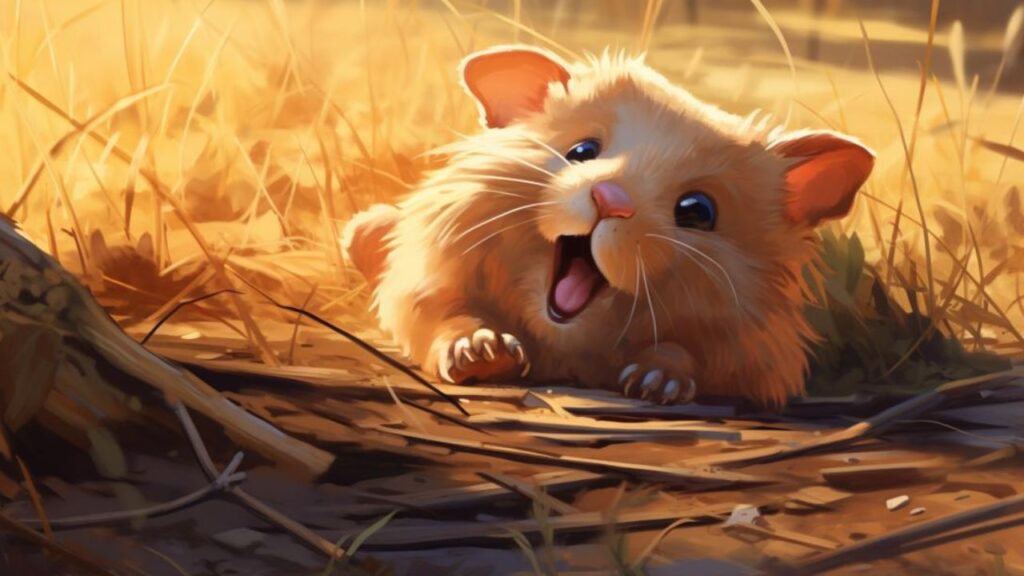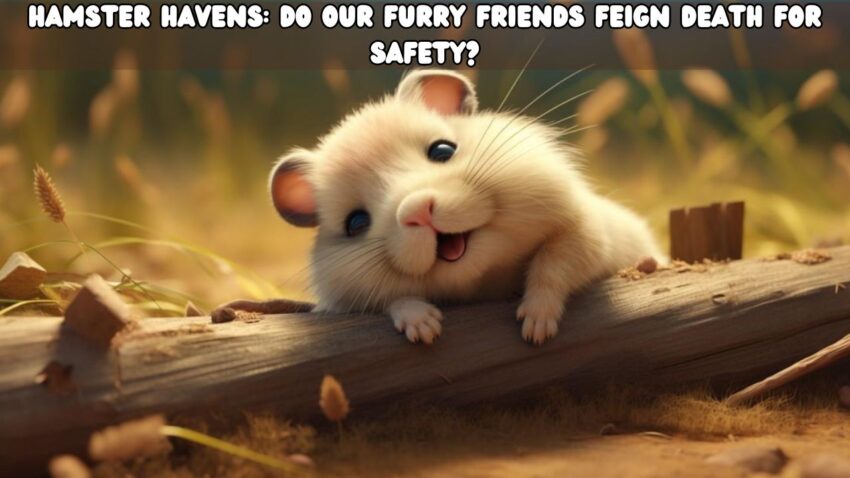TL;DR Summary:
Hamsters do not typically play dead in the same way some animals exhibit thanatosis. They might freeze or appear very still when frightened or stressed, which can be mistaken for playing dead. Understanding these stress-related behaviors is important for providing proper care and ensuring the well-being of a hamster. Always observe your hamster for signs of stress and respond promptly to their needs for a happy and healthy pet. Remember, a happy hamster is a wheel-y happy you!
In the vast and varied tapestry of the animal kingdom, survival often hinges on an organism’s ability to adapt and protect itself from predators. One of the most dramatic behaviors observed is thanatosis, commonly known as ‘playing dead.’ This defense mechanism is as intriguing as it is effective, compelling predators to lose interest in what appears to be lifeless prey.
Thanatosis: Nature’s Grand Deception
Thanatosis is an involuntary reaction for some species, a last-ditch effort to evade death’s clutches. In a world where the line between predator and prey is starkly drawn, the ability to feign death can mean the difference between survival and being the next meal. It’s a behavior that fascinates both the casual observer and the seasoned biologist alike.
Hamsters and the Art of Playing Dead
But does this instinct extend to the realm of the small and seemingly defenseless hamster? These domesticated creatures, far removed from their wild ancestors’ fight for survival, rarely face the predators that would trigger such a dramatic response. Yet, understanding whether hamsters possess this behavior is significant for several reasons:
- Health Monitoring: Distinguishing between a hamster playing dead and one that is experiencing a health emergency is crucial for proper care.
- Stress Response: If hamsters do exhibit thanatosis, it would be a clear indicator of extreme stress, signaling a need to reassess their living conditions.
Understanding Thanatosis in Animals

In the tapestry of survival strategies that nature weaves, thanatosis stands out as one of the most intriguing. This term, derived from the Greek word for death, refers to the behavior exhibited by some animals when they feign death in the face of an imminent threat. It’s a behavioral adaptation that serves as a last line of defense, and its expression is as varied as the species that employ it.
Defining Thanatosis: Nature’s Ruse
Thanatosis is the act of mimicking death to avoid being eaten by a predator. During this state, the animal will become rigid and unresponsive, often adopting a posture indicative of death. This behavior can confuse or deter a predator, as many prefer live prey or may be cautious of consuming an animal that has died from unknown causes.
The Strategy Behind Playing Dead
The purpose of thanatosis extends beyond merely tricking a predator. It’s a sophisticated survival mechanism that can:
- Interrupt a Predator’s Attack: The sudden ‘death’ of their prey can cause a predator to pause, providing the ‘deceased’ with an opportunity to escape when the predator is distracted.
- Avoid Detection: In some cases, remaining motionless can prevent detection in the first place, as movement often catches the eye of a predator.
Examples in the Animal Kingdom
Various animals have mastered the art of playing dead, each adapting the behavior to their unique ecological niches:
- Opossums: Perhaps the most famous practitioners of thanatosis, opossums will collapse and become stiff, sometimes emitting a foul odor to further convince predators of their demise.
- Hognose Snakes: When threatened, these snakes will flip onto their backs, open their mouths, and emit a foul smell to simulate death convincingly.
- Certain Birds: Some species of birds, like the Eurasian bullfinch, will lie motionless on their backs when caught, only to fly away when the threat has moved on.
Thanatosis Across Environments
Thanatosis is not limited to any one environment; it’s a behavior seen in marine life, such as certain types of sharks, as well as in insects and terrestrial mammals. It is a testament to the effectiveness of thanatosis that it has evolved independently across such a diverse array of life forms.
Do Hamsters Play Dead?

The phenomenon of playing dead as a survival tactic is well-documented in various animal species, but when it comes to hamsters, the scenario is less clear-cut. These small rodents have captivated the hearts of many as pets, yet their behaviors can sometimes be misunderstood or misinterpreted.
Investigating Thanatosis in Hamsters
There is no extensive scientific literature to suggest that thanatosis is a common behavior in hamsters. Unlike their wild counterparts who have evolved behaviors to evade predators, domesticated hamsters typically do not need such extreme defense mechanisms. However, this does not mean they are incapable of such responses.
Misinterpretations and True Reactions
Hamsters may exhibit behaviors that could be mistaken for playing dead:
- Freezing: Hamsters might freeze in place when startled or scared, which is a common response to a perceived threat but is not the same as thanatosis.
- Stress or Illness: A hamster that is lethargic or unresponsive may be suffering from stress, illness, or injury, rather than intentionally playing dead.
- Deep Sleep: Sometimes, hamsters can enter a state of deep sleep where they are very still, and their breathing is shallow, which could be mistaken for thanatosis.
Reasons Behind Apparent Thanatosis
If a hamster were to exhibit a behavior akin to playing dead, it might be due to several reasons:
- Extreme Stress: In the face of severe stress or a traumatic event, a hamster might become immobile as a form of shock response.
- Defensive Behavior: While not true thanatosis, a hamster may instinctually hold still for extended periods if it feels there is no escape from a threat.
- Breed-Specific Traits: Some breeds or individual hamsters may have unique responses to fear that resemble playing dead more closely than others.
Whisker Tips: Recognizing and Responding to Hamster Behaviors

Hamsters, with their varied personalities and behaviors, can sometimes leave their owners puzzled. Knowing how to differentiate between a hamster’s quirky antics and signs of distress is key to ensuring their health and happiness. Here are some ‘Whisker Tips’ to help hamster owners recognize and respond appropriately to their pet’s behaviors.
Distinguishing Playful Behaviors from Medical Emergencies
Observation is crucial when it comes to understanding hamster behaviors:
- Normal Play: Hamsters may occasionally flop over or lie still during play or grooming, but they will generally be responsive to gentle stimuli.
- Freezing Behavior: A startled hamster might freeze for a moment but will typically resume activity once the perceived threat has passed.
- Medical Concern: If your hamster is unresponsive, check for breathing and any signs of injury or pain. An unresponsive state that isn’t followed by prompt activity may require immediate veterinary attention.
Steps to Take with an Unresponsive Hamster
If you suspect your hamster is playing dead or find them unresponsive, follow these steps:
- Gentle Check: Gently nudge your hamster or call their name. Avoid loud noises or sudden movements that could startle them further.
- Look for Breathing: Watch closely for any subtle movement that could indicate breathing, such as the slight rise and fall of their belly.
- Check for Injuries: If they are breathing but still not moving, carefully check for any visible signs of injury or distress.
- Warmth and Comfort: If there are no visible injuries and the environment is cold, try gently warming your hamster with your hands or a soft towel to see if they become more responsive.
- Seek Veterinary Care: If your hamster remains unresponsive, or if you suspect illness or injury, contact a veterinarian immediately.
Recognizing Stress Signs
Understanding the signs of stress in hamsters can help prevent misinterpretation of their behaviors:
- Agitation: A stressed hamster may exhibit agitated behavior, such as pacing or attempting to escape the cage.
- Changes in Eating or Grooming Habits: A marked change in these habits can be a sign of stress or illness.
- Vocalizations: While hamsters are typically quiet, stress or pain may elicit vocalizations such as squeaks or hisses.
The Hamster’s Stress Response

In the wild, hamsters are prey animals, and their stress responses are highly attuned survival mechanisms. Understanding how domestic hamsters react to stress and perceived threats is crucial for providing a safe and nurturing environment.
Recognizing Stress in Hamsters
Hamsters exhibit several behavioral and physiological signs in response to stress:
- Behavioral Changes: A normally active hamster may become withdrawn, or a typically docile hamster may become aggressive.
- Physical Symptoms: Stress can manifest physically, showing symptoms such as fur loss, changes in eating or sleeping patterns, and even diarrhea.
Psychological Aspects of Stress
The psychological impact of stress on hamsters can be profound:
- Mental Health: Chronic stress can lead to depression or anxiety in hamsters, impacting their overall well-being.
- Behavioral Disorders: Prolonged exposure to stressors can result in behavioral disorders, such as obsessive-compulsive bar chewing or circling in their cages.
Physiological Responses to Threats
When facing an immediate threat, hamsters may respond with:
- Freezing: This response serves to make them less visible or to assess the situation. It’s a moment of stillness that can precede flight.
- Fleeing: As burrowers, hamsters’ first instinct is to escape and hide from danger.
- Fighting: If cornered, hamsters may exhibit defensive behavior, including biting.
Stress and the Domestic Hamster
In a domestic setting, hamsters may perceive threats differently:
- Environmental Stressors: Loud noises, sudden movements, or improper handling can elicit a stress response.
- Cage Stress: A cage that is too small, lacks enrichment, or is in a high-traffic area can be a constant source of stress for a hamster.
- Social Stress: Hamsters are generally solitary and can experience stress if housed with other hamsters.
Managing and Mitigating Stress
To manage your hamster’s stress effectively:
- Create a Safe Haven: Ensure their cage is a quiet, calm place with plenty of space for exercise and hiding spots.
- Routine and Familiarity: Keep a consistent routine for feeding and cage cleaning to avoid unsettling surprises.
- Observation and Adjustment: Regularly observe your hamster’s behavior and make adjustments to their environment as needed.
Conclusion: Deciphering the Silent Signals of Hamster Behavior

As we draw the curtains on our discussion about hamsters and the intriguing concept of playing dead, it’s clear that while thanatosis is not a routine part of hamster behavior, their responses to fear and stress are complex and multifaceted.
Summing Up the Hamster’s Survival Tactics
Hamsters, with their instinctual roots in the wild, possess a range of behaviors to cope with stress and perceived threats. While freezing or stillness can sometimes be misinterpreted as playing dead, these reactions are more about assessing danger or shock response rather than a deliberate act of deception as seen in thanatosis.
The Nuances of Hamster Behaviors
Throughout this exploration, we’ve seen that understanding the nuances of hamster behavior is crucial for their care:
- Stress and Health: Identifying signs of stress early on can prevent health issues and ensure the well-being of our furry companions.
- Environment and Care: Providing an enriching and comfortable environment is key to preventing stress-induced behaviors.
- Knowledge and Observation: Educating ourselves about natural hamster behaviors and maintaining a watchful eye are essential to nurturing a happy hamster.
Encouraging Hamster Happiness
We, as caregivers, must be ever vigilant and responsive to our hamster’s needs. Recognizing that what might appear as playing dead could be a sign of distress, illness, or simply a deep slumber, is paramount. It is our responsibility to create a setting where stress is minimized, and comfort is maximized.
In conclusion, while the mystery of hamsters playing dead is largely dispelled, the importance of understanding all aspects of hamster behavior remains. It is through this understanding that we can provide the highest quality of care, ensuring our small companions lead full and joyous lives. As we move forward, caring for these endearing creatures, let’s carry with us the knowledge that a well-understood hamster is a well-loved hamster. And as always, remember, a happy hamster is a wheel-y happy you!




